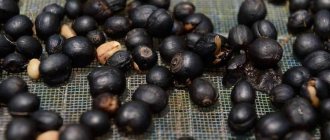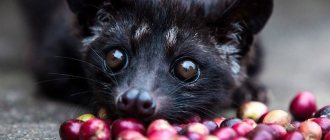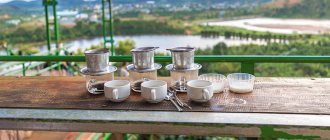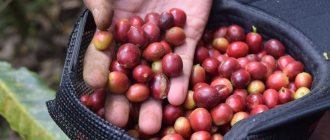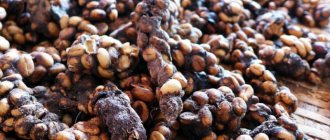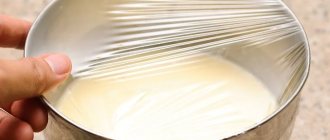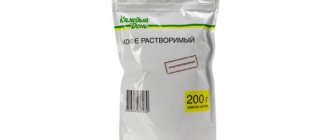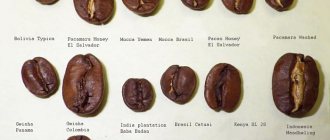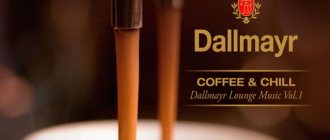Asian Luwak coffee is considered the most expensive due to the difficulty in obtaining the beans and the high quality of the finished drink. The grains must first pass through the digestive tract of palm martens, or musangs. The stomach juice of these mammals eliminates bitterness and contributes to the appearance of a chocolate flavor in the product.
Origin of Luwak coffee.
The Legend of Luwak and the History of the Origin of Coffee
Luwak production began in Sumatra. The colonialists imposed heavy taxes on coffee beans exported from the island. To avoid waste, local residents fed lemur-like animals, civets, with berries.
The grains then had to be washed out of their droppings. The taste of the drink changed. When producers noted this feature, a new variety was born, which quickly became expensive and elite.
According to legend, a peasant from the island of Sumatra was the first to extract grain from excrement. Palm martens, otherwise known as luwak, ate the entire coffee berry crop.
The peasant lived in poverty, so such an incident became a tragedy for him. He, however, noticed that the animals left behind feces in which whole coffee beans were visible. After thinking a little, the man began to remove the coffee from the excrement.
Producer followers
The island of Sumatra is not the only place where Luwak is produced. Suppliers of fermented grains also include Vietnam, the Philippines, and Indonesia. Production takes place in each palm civet habitat.
In Thailand, Black Tusk coffee is produced in a similar way. Instead of musangs, local residents feed the berries to elephants. To obtain a high quality drink, only Thai Arabica is used. The cost of a cup of coffee in some hotels is $50.
How coffee is made
The process of making the exotic drink Luwak, named after palm civets, includes several stages:
- Drying excrement. Feces are processed naturally, spread out on special sheets.
- Extraction. Farm employees extract coffee beans by hand. At the same stage, quality material is selected.
- Flushing. Selected grains are washed several times in water.
- Drying. The washed material is dried again in the open air.
- Roasting. Various varieties of Luwak have emerged through the use of several methods of roasting the beans. Each method gives the drink a special taste. The most common processing is using sweet syrup.
Characteristics of the drink
The drink made from grain that has passed through the stomach of an animal is very different from other types of coffee.
Taste characteristics
There is no bitterness characteristic of classic coffee, and there is no sourness either. The taste is soft, creamy chocolate. The drink smells like cocoa and caramel.
Differences from regular Arabica
Due to the peculiarities of obtaining raw materials, Luwak coffee has a lower strength than Arabica coffee. Its taste is less tart and has a greater number of shades. The cost of Luwak is several times higher than the price of Arabica. Because of this, the elite variety of coffee is even called the “drink of the gods.”
Effect on the human body
Thanks to the caffeine contained in coffee, activity increases and a person feels alert. Drinking 1 cup allows you to increase your performance by 10-12%.
Brain activity is stimulated. The weight loss process accelerates. Caffeine helps break down fat cells.
In addition, luwak eliminates cravings for high-calorie foods. The drink strengthens the immune system, prevents the development of inflammatory processes, and increases resistance to infections.
Coffee strengthens the immune system.
The special taste of kopi luwak and its characteristics
The most expensive type of coffee is obtained by passing the beans through the digestive tract of the palm civet, also called musang or luwak. After the coffee fruit (cherry) enters the animal’s body, the pulp is digested. Digestive fluids have little effect on grains. The product used in production leaves the body along with feces.
Coffee made from animal feces has a chocolate or caramel flavor. The bitterness of the drink is given by civet, a special enzyme secreted by the glands of the anus of the musang. Kopi luwak coffee gets its special taste thanks to the enzymes found in the civet’s stomach.
Such luwak can be prepared artificially. To do this, the grains are sprayed with civet obtained in the laboratory. Luwak coffee made from poop is faked by adding flavorings and flavorings. However, a connoisseur is able to identify a fake or artificially obtained drink. The taste of the product is influenced by coffee varieties, the best of which is Arabica.
Nuances of production in different countries
The coffee production process differs depending on the country.
Indonesia
Indonesian farmers search the area early in the morning, before the sun has yet to warm the ground, to find the freshest wild animal droppings. Immediately after discovery, they contact the buyer, who inspects the excrement and determines whether the grain meets the standards.
Once the coffee arrives at the facility, it is immediately washed and the water is left for analysis to determine whether the feces came from a wild civet or a caged civet.
Vietnam
In Vietnam, the quality of luwak is worse than in Indonesia. Civets on farms are fed not only selected coffee berries. The animals' diet is very different from their natural diet, which affects the taste of the fermented grain.
In addition, under the guise of luwak, they often sell a mixture of coffee that has passed through the digestive system of musangs with robusta and arabica. The concentration of fermented grain can be 1-5% of the total mass.
Feeding animals.
Philippines
The production of luwak is carried out by the inhabitants of the southern part of the Philippines. Animals that eat coffee berries prefer to settle near the mountains. Local residents inspect the forest area every morning to find feces of wild civets.
The number of animals, however, is rapidly declining due to the use of civet produced by martens in perfumery.
Description and features
The cute animal has a slender and long body with short limbs. The musang in the photo gives the impression of being a hybrid of a cat and a ferret. The gray fur is thick, hard on top, with a soft undercoat inside.
The back is decorated with black stripes, the fur is marked with dark spots on the sides. The ears and paws are always darker; the black elongated muzzle has a characteristic white mask or white spots. Slight differences in color appear among species in different habitats.
The animal has a wide head, a narrow muzzle, with large, slightly bulging eyes, and a large nose. Small rounded ears set wide apart. A real forest musang hunter is armed with sharp teeth and claws on strong paws, which the predator hides in its pads as unnecessary, like a domestic cat. The dexterous and flexible animal is an excellent climber and lives mainly in trees.
The length of a mature musang is approximately 120 cm from the nose to the tip of the tail, the size of which is more than half a meter. The weight of an adult varies from 2.5 to 4 kg. The scientific description of the species includes the concept hermaphroditus, which was erroneously attributed to the musang because of the protruding glands in males and females that resemble the shape of the gonads of males.
Most of the time the musang lives in trees
Later they found out that the purpose of the organ is to mark the territory of home areas with secretions, or odorous contents with the smell of musk. No pronounced differences are observed between males and females.
Animals that ferment coffee
In addition to musangs, elephants can ferment coffee. The animals' diet includes vegetables, fruits, and sugar cane. Veterinarians ensure that the concentration of caffeine in the blood of animals does not exceed the norm.
Brazilians obtain fermented grains with the help of gray parrots. The birds' diet includes local fruits and nuts. Residents of South America prefer to create conditions close to natural for their parrots, so the taste and smell of coffee from the farm is almost no different from wild coffee.
Fermentation of grains can occur in the digestive system of some species of monkeys. Coffee varieties derived from primates are considered less elite than Luwak.
The history of the discovery of the most expensive coffee drink
It all started on the island of Sumatra. Several centuries ago, it was one of the territories used by the colonialists. At that time, they imposed a large tax on local residents for the supply of coffee. Therefore, people had to flush out the coffee beans from the droppings of a pest animal called “luwak”, which is similar to a lemur.
Over time, residents noticed that a drink made from grains that had undergone a fermentation process in the stomach of a rodent turns out to be refined and unusual in taste. It was then that the variety of this coffee with the Indonesian name “kopi luwak” was born, which today is rated quite highly. Interestingly, this industry subsequently brought people out of the crisis.
An animal in whose stomach grains undergo a fermentation process is called luwak.
Varietal varieties
In addition to the classic Copi Luwak, gourmets can try other varieties of the expensive drink.
Black Ivory
Black tusk is processed in the stomachs of elephants. The cost of 1 kg of grain starts at $1,080, and for a cup you will have to pay at least $50.
This variety is not available for sale; it can only be purchased in the Anantara Nature Reserve. Only a few expensive Thai hotels offer the finished drink to guests.
Elite Black Ivory coffee.
Jacques Bird
This Brazilian variety is fermented in the digestive system of Gray parrots. The living conditions of birds on farms are as close to natural as possible; there are no cages.
Freshly roasted coffee is characterized by the aroma of dried black bread with notes of molasses. There is a fruity aftertaste. The price of 1 kg of coffee starts from $430.
Brazilian variety Jacquou Bird.
Coffee Terra Nera
Palm civets are used to produce this variety. Ready, freshly roasted coffee smells of hazelnuts and cocoa. Due to the small volume of production, the cost of the product increases to $1,500 per 1 kg.
The beans are sold only in a single coffee shop in London.
Luxury products are packaged in silver paper with a flap to preserve the aroma. The pack is supplied with a 24-karat gold tag, on which the client’s name can be engraved if desired.
Golden Coffee Terra Nera.
How much does the most expensive coffee cost?
The price of Luwak coffee starts from $600 per 1 kilogram of product. The most expensive and most delicious drink, according to connoisseurs, can be made from Vietnamese grains. 1 kg of such a fermented product costs at least $7 thousand. The price of elite grains is determined by some production features:
- Staff costs are high. Employees need to be paid. Often workers live on farms, which requires food and maintenance costs. The owner is forced to pay for the services of a veterinarian who monitors the health of the animals.
- The owner of the production combines 2 farms in one. The owner is obliged to take care not only of animals, but also of plants.
- The lack of technology in extracting grains from manure slows down the production process. You can get a small portion of the product per day.
- You can give coffee to animals no more than 2-3 times a week. The basis of the animals' diet is soups made from chicken broth with the addition of corn and rice. The civet's stomach is not capable of processing large portions of coffee. Excess grains will not receive the necessary taste and smell.
- The animal chooses the fruits independently. Civets eat only ripe “cherries”. Fruits that animals refuse to eat must be disposed of. This increases costs. On some plantations, animals are invited to choose fruits directly on the branches.
Kopi Luwak coffee obtained from wild animals can be more expensive than beans from farmed animals. This is due to the need to search for excrement. However, drinking such a drink is not always safe for humans. The animal that ate the fruit may have been unwell.
Some farms offer Luwak tasting. A cup of Luwak costs $5. However, many farms cooperate with coffee packaging companies, and visitors may be offered a pre-packaged product.
You can purchase luwak outside the countries of production in specialized stores. The seller must have a license to sell such products. Due to the high risk of counterfeiting, you should not buy the drink online. You should not purchase a product with big discounts, New Year promotions, etc. Genuine Luwak cannot be cheap.
Interesting! Mocha coffee variety - how it differs from the rest, the most popular varieties and roasts
Rules for preparing the drink
Recipes for making the drink differ depending on the country. Be sure to use purified cold water. Liquid at room temperature is not suitable, since the taste of the drink is not revealed when used. Do not cook luwak in hard tap water, replace it with filtered or bottled water.
With spices
Pour 1 clove star into the cezve, 5 pcs. cardamom, 0.5 tsp. ground ginger. Add 3 tsp. pre-ground coffee beans.
Pour 250 ml of cold water, then place the Turk over low heat. Wait until the foam rises, remove the cezve from the stove. Repeat twice more, then strain the drink.
Coffee with cardamom.
In Turk
Preheat the Turk. Then add 2 tsp. crushed grains, add 1-2 tsp if desired. granulated sugar. Warm the mixture slightly, then add cold water. Cook over low heat until foam rises. Then remove the Turk from the stove and pour the coffee into cups.
Flavored coffee.
In Vietnamese
To make Vietnamese coffee you will need a special filter press. Place the device over the cup, fill 2-3 tsp. ground coffee.
The coffee powder is compacted and then poured with a portion of water. After 0.5 minutes, add a little more liquid. Then they wait until the water has completely flowed into the cup and drink immediately. To get warm coffee, it is recommended to first place the mug in a container of hot water.
Vietnamese coffee.
How to find coffee plantations in Bali
Almost all coffee plantations on the island of Bali are located on the road that leads to Kintamani.
There are several plantations there and Kopi Luwak signs are posted on the roads. There are few accommodation options to stay near the plantations. One of the hotels nearby is called Bali Eco Advanture Resort.
Real Luwak coffee. In fact, the coffee plantations in Bali that produce Luwak coffee are more like a tourist attraction. In fact, real Luwak coffee must be made from beans selected from the excrement of wild civet cats. This is the main advantage of real coffee. In the wild, the animals will not eat just anything; they select only the highest quality and ripe fruits.
Finding such coffee, made according to all the rules, is not easy and it will be very expensive. The main wild plantations are located on the islands of Java, Sumatra and Sulawesi. But in places for tourists, such as Bali, there is a very high probability of running into a fake. There are also real wild plantations in Bali, but they do not conduct any excursions, but work only with wholesalers, so an ordinary tourist cannot even buy anything from them.
Therefore, if you are a true coffee connoisseur, then you should try the real Kopi Luwak, produced by wild civets.
Also, if you want to try this coffee, but don’t plan to go to Bali yet, you can buy it in Russia. There is a store called Luwak.rf, which sells real Luwak coffee in Moscow with all the necessary documents.
Criterias of choice
When choosing grains, consider a number of criteria:
- There should be no glossy shine. This feature indicates roasting using palm oil. Sometimes shine occurs due to too rapid heat treatment. This is beneficial for the manufacturer because it saves time. The taste of the product, however, deteriorates.
- Take a closer look at the grains. The packaging must not be broken or damaged. If the grains of one blend differ in size, it is better to refrain from purchasing.
- A price that is too low indicates a fake. Luwak coffee costs from $200 per 100 g; it is not profitable for the manufacturer to sell the product cheaper.
- Flavorings are not allowed. Their use indicates low grain quality.
How is it different from regular Arabica?
If you compare these two types of coffee, you can find differences in a variety of areas.
The first, of course, is the method. For Arabica beans, a standard technology familiar to everyone is used. In Kopi Luwak there is an unusual and at first glance strange method. All other opposites follow from this.
Luwak is characterized by a variety of flavors and a caramel-chocolate aroma.
For example, the first of the drinks has a fairly strong strength, tart aroma and taste. The second one is characterized by a variety of flavor shades and a caramel-chocolate aroma.
In terms of strength, Luwak does not reach the level of Arabica, which for some coffee lovers was a pleasant discovery. And the most important thing is the price. Luwak coffee is called the drink of the Gods. And already in this one can see the high cost, especially when compared with the familiar Arabica.
What causes the high cost of Luwak coffee?
The cost of production is high for 3 reasons:
- Small production volume. The mass of grains in the feces of the palm marten is small. Making “wild” coffee is further complicated by the need to search for excrement in the forests where the musangs live.
- Palm civets produce civetin, a substance necessary for processing grains in the digestive tract, for only 6 months of the year. At other times, the farms are idle and no drink is produced. Often animals are released into the wild during this period so as not to spend money on their maintenance.
- Musangs do not breed in captivity, so farmers have to regularly catch new individuals in the forests.
Musangs do not have offspring in captivity.
WHAT IS THIS BEAST, CIVETTA?
The genus of civets, or civets, is part of the civet family. These are carnivorous mammals that live in the tropical regions of Africa, southeast and southern Asia. In countries where English is spoken, these animals are called civets , in all others - civets or civets . There are 35 species included in 15 genera from the viverridae family. The most famous of them belong to the genera of civets: Owston's civet, otter civet, Kalimantan civet, striped civet, three-striped civet, Sulawesi civet, Himalayan civet, African civet, small civet, musang. Different species of civets have different body sizes. The smallest are the small civet, palm civet, three-lined civet - 45-55 cm body length, 1.7-2.5 kg in weight. Large civet species reach 80 cm in length and 7-9 kg body weight. The tails of different species of civets are of different lengths: some are almost the same as the body length, some are shorter. Almost all types of civets, in addition to small species of living creatures (birds, squirrels, rats, amphibians, worms, beetles, crustaceans, etc.), also feed on fruits, fruits, nuts, and roots. Civets are nocturnal animals. Only during the mating season are they active during daylight hours. Their main location is trees. Civets are the best of all predatory animals to move through trees, almost like squirrels. Many species of civets make nests in hollows. But some inhabit caves, burrows and human buildings (barns, stables). Some species of civets give birth once a year, and some - twice. They usually have 2-3 cubs per litter, some species have up to 5 cubs. The female feeds them with milk for a year. The lifespan of viverrids ranges from 5-7 years to 15 years in the wild. In captivity, some animals lived up to 25 years.
photo: Civets
Interesting Facts
The legend about the origin of this type of coffee is funny and educational, but there are many more interesting facts about this extraordinary drink:
- Kopi Luwak is often criticized by environmentalists. Coffee berries are not the basis of the diet of martens; excess caffeine has a negative effect on the animal’s body. In addition, on farms the animal is often kept in poor conditions.
- In captivity, the musang eats approximately 1 kg of berries daily. A daily portion of excrement contains no more than 60-70 g of grains.
- Every year, only about 300 kg of Kopi Luwak enters the world market. Most lovers of expensive coffee are in the UK, Hong Kong, and Japan.
- In Vietnam, luwak is traditionally served over ice. If desired, condensed milk can be added to the drink. Additionally, a cup of green tea is served.
Lifestyle and habitat
Palm martens live in tropical and subtropical moist forests across the vast territory of Indochina and numerous islands of South Asia. In mountainous areas, the animal lives at altitudes of up to 2500 meters. The natural habitat of animals is in Malaysia, Laos, Cambodia, Vietnam, Thailand. In many places the musang animal is an introduced species. The animals acclimatized in Japan, Java, and Sulawesi.
Palm martens are active at night. During the daytime, animals sleep in hollows and on branchy forks. Palm martens live alone; only during the breeding season does communication with individuals of the opposite sex begin.
The animals are very common, appearing in parks, garden plots, and farms, where martens are attracted to fruit trees. If a person treats forest guests peacefully, then musangs inhabit stables, roofs, and attics of houses.
In some countries, musangs are kept as pets.
They reveal their appearance by being active at night, which often irritates their owners. In houses where musangs live as pets, there are no rats or mice, with which representatives of civets deal brilliantly. In relation to their owners, palm martens are affectionate, good-natured, and flexible.
